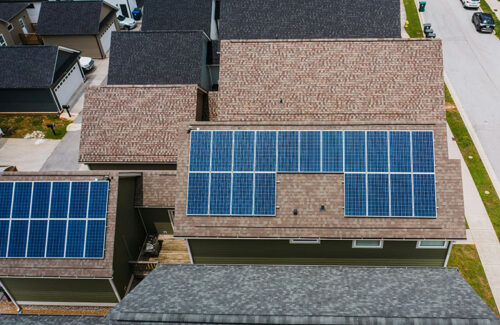 The magic of solar panels — that they generate energy simply using rays from the sun — also makes them tricky to turn off when things go wrong.
The magic of solar panels — that they generate energy simply using rays from the sun — also makes them tricky to turn off when things go wrong.
When firefighters arrive to battle a blaze at a home without solar panels, they can shut off the main power and rest assured there is no dangerous voltage in the home. When a rooftop solar array is involved, it’s a different story.
“Let’s face it, you look at a PV panel, there’s no off button. There’s no switch to turn it off. The moment you take it out of the box and expose it to any light source sufficient enough to start generating power, it’s up, and that’s why the code requires several disconnects,” said Dean Austin, senior electrical content specialist at the National Fire Protection Association (NFPA).
The requirement for “rapid shutdown” of a solar array was established in the 2017 National Electrical Code (NEC) by the NFPA with the goal of protecting firefighters from high DC voltage in house fires with rooftop solar. The concept was introduced by the National Electrical Contractors Association, solar installers and inverter manufacturers via public input to the NFPA, Austin said. The NFPA then created a task group of firefighters and solar stakeholders to determine fire safety design requirements.
The resulting module-level rapid shutdown requirements under NEC 690.12 added new design constraints to residential and commercial rooftop solar projects, requiring a switch that reduces the voltage of each panel within 30 seconds. Along with rapid shutdown devices (RSDs), microinverters can also satisfy the requirements, since they convert the high-voltage DC power to lower AC power at the panel-level.
A few years later, the NEC was further updated to allow UL 3741-compliant PV hazard control systems to satisfy rooftop fire safety requirements too. For this method, solar components are tested together to ensure they’re not dangerous to a first responder in full gear. Approved products could then be used in place of RSDs and other module-level power electronics (MLPE), but the string inverters are required to be installed no more than 12 in. from the array. This is usually an easy option for commercial projects but not residential rooftops. That leaves rapid shutdown as the main option for the residential market.
RSD troubles

An MLPE device that melted down on a project. Credit: HelioVolta
While the goal of rapid shutdown is important, it’s not without issues. Requirements to install more power electronics in tough rooftop conditions, along with more of one particularly failure-prone component, have frustrated some residential installers and engineering companies. A few have even questioned if they’re actually making systems safer — or the opposite.
“On the surface, rapid shutdown sound like a good idea. It’s not a bad thing to get the DC voltage down very quickly to a low number. But the problem is in the implementation. It’s kind of a race to the bottom with manufacturers of rapid shutdown units, and to trust really any electronics to last for 25 or 30 years and be perfect is asking a lot when it’s outdoors, underneath very hot solar panels,” said Peter Greenberg, owner of Oregon solar installer Energy Wise Services, and a former firefighter and paramedic.
Greenberg said he has installed numerous RSD brands that have overheated, melted or even caught fire on projects, but it’s still difficult to point to a cause of the failures.
“A big problem is, if there is a fire, nobody talks about it. People get insurance settlements, they sign NDAs and nobody talks,” he said. “I’ve talked to different committees and they say, ‘Well, show us. Show us proof that these things aren’t good.’ There is no proof.”
Connector conundrum
One known issue on solar projects that is exacerbated by RSDs is connector failures. In a study focused on inspections of 5 GW of commercial and utility-scale projects, engineering firm HelioVolta found 83% suffered from at least one connector-related issue.
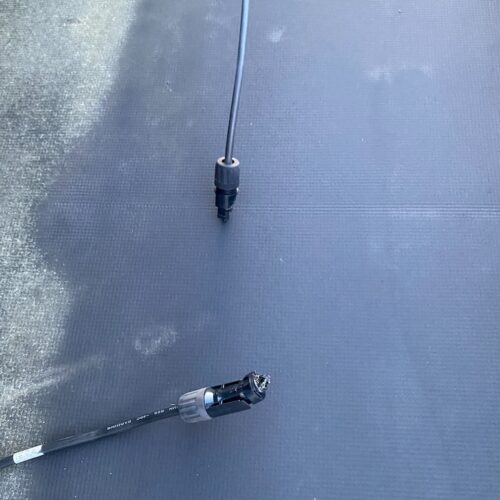
A melted connector. Credit: HelioVolta
“It’s absurd that one of the cheapest components in a PV system is responsible for the industry’s most notorious failures,” said David Penalva, CEO of HelioVolta, of the study. “We’re talking about a dollar’s worth of plastic and metal putting multimillion-dollar assets — and people — at risk. It’s unacceptable.”
There are more than 200 connector brands on the market for joining module strings and MLPE, but NEC restricts cross-mating of different brands. When connectors don’t match, installers need to use jumpers, which are cable extensions that match with cable brand A on one side and B on the other. Every connection adds more potential failure points to a project.
“It’s already complicated if you have components that are not matching, but when you add the MLPE, everything gets exponential,” said David Penalva, co-founder of HelioVolta. “Now you’re dealing not only with the module connectors, but now the MLPE connectors, and if they don’t match, you have to now add the third one, which is the jumper. And we’ve been having a lot of issues with jumpers.”
The sheer number of different connector options increases the possibility of installation error. Expecting installers to keep up with 200+ user manuals is not realistic, Penalva said. There are plenty of reputable brands that installers know well, but also many other China-manufactured non-UL-listed connectors that don’t have any documentation at all. Regardless of brand reliability, any number of connectors involved increases potential failure points on a project.
HelioVolta published a risk analysis in its latest “PV Connectors: The State of the Field” report that shows projects using module-to-MLPE jumpers have the highest risk, largely due to the sheer number of connectors on the project. Penalva said HelioVolta has been involved in several fires associated with MLPE.
“Sometimes developers or asset owners don’t realize how much more risk they are taking by making a decision on the system configuration,” Penalva said.
Firefighter perspective
Retired firefighter-captain for Las Vegas Fire & Rescue and early solar DIYer Richard Birt said in his early 2000s off-grid home, he had to hardwire electrical boxes on the back of each panel. The industry has come a long way since then but still has much room for improvement.
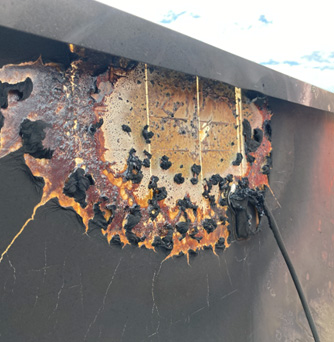
The aftermath of a catastrophic MLPE failure. Credit: HelioVolta
“This plug-and-play of these MC4 connectors is brilliant. The trouble is, that little plastic connector is under pressure constantly because of weather, temperature and high voltage. To me, high voltage is like high pressure in a hose,” he said.
Birt retired from firefighting in 2020 to focus on Solar And Fire Education (S.A.F.E.), a free program where he travels the world teaching firefighters how to mitigate fire incidents involving solar + storage systems. He too has seen melted-down MLPE in the field.
“I have fire investigators send me pictures of optimizers with a big hole melted through them, and the only [reason] there’s a big hole in an optimizer melted right through on a roof is because there were 600+ volts going through the optimizer,” Birt said.
If he had his way, every residential system would use microinverters that convert the DC power to much lower AC voltage at the panel level.
“The critical thing is that MC4 connector is at low pressure [in a microinverter]. It’s 70 VDC. If it arcs, there isn’t enough juice to make it burn,” Birt said. “That microinverter shuts down immediately if there’s any kind of arc.”
RSD safety efforts
After seeing the studies showing the high failure rates of connectors, especially non-UL-listed options, MLPE manufacturer Tigo Energy switched to 100% Stäubli MC4 connectors. The company’s warranty is now voided if installers use anything else.
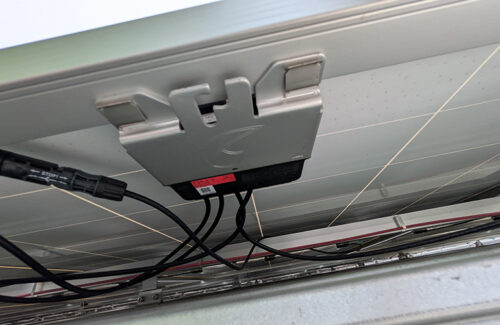
Tigo Energy’s TS4-A-F rapid shutdown device.
As far as MLPE reliability, Tigo stands by its products and points to even more advanced fire protection efforts. While the NEC only requires manual rapid shutdown, Tigo and other RSD manufacturers are producing devices that shut down automatically when they sense an error.
Gal Bauer, senior director of validation, growth and product management at Tigo, recalls getting a call from a customer that a Tigo solar system must be broken, because it wasn’t generating any power. When Tigo representatives got to the site, they found a fallen tree branch had damaged a few modules atop the metal roof, and the rapid shutdown device prevented the system from turning back on in dangerous conditions.
“The tree could’ve caught fire, the electrical, the conduits with the high DC voltage touching the metal roof could have gotten the whole place electrocuted — totally dangerous. So is rapid shutdown making systems safer? In my opinion, absolutely, yes,” Bauer said.
In a quest to keep improving the product, Tigo has also worked to eliminate “crosstalk” issues with its Pure Signal technology — aiming to cut back on signal interference from the many MLPE units overlapping while communicating over powerlines and erroneously shutting down systems.
Even with Pure Signal technology, Tigo said installers still need to ensure they’re installing systems according to the guidelines.
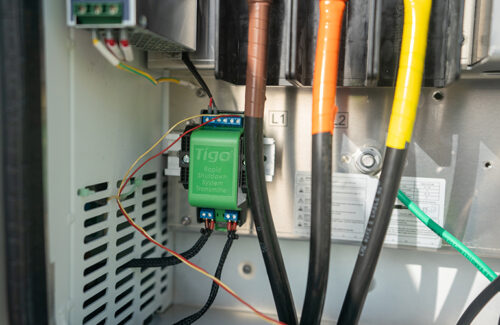
Tigo’s RSS Transmitter with Pure Signal Technology.
“It still doesn’t mean that installer shouldn’t follow good sound practices. It’s like, go back to the analogy of cars, just because you have anti-lock brakes and air bags doesn’t mean you should drive crazy, but if you do follow the practices and have Pure Signal, it’s less prone to a little bit of human error,” said JD Dillon, chief marketing and customer experience officer at Tigo.
Although the requirements have been in place for years now, fire safety requirements are still causing growing pains for the industry. More stringent industry standards for connectors, continuously improving rapid shutdown products and stronger installer training on RSDs could be a start to removing some of the risks hanging over residential rooftops.

